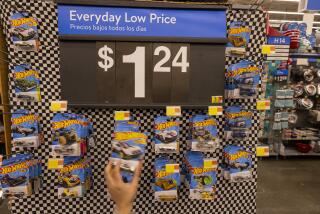VIEWPOINTS : How Much? Don’t Ask : ‘Pay Here’ Booths and Bar Codes Don’t Always Make It Any Easier for Customer : Price tags are disappearing. Signs are getting moved or lost. Customers are being left in the dark. And retailers deny that this is happening.
- Share via
SAN FRANCISCO — Recently I went shopping for a new toaster. The factory-sealed box, which I picked from a piled-up merchandise display, was marked with a bar code. There was no price shown anywhere. There was no price information on the display fixture, either--no tag, no sign. At the “Pay Here” island I asked, “How much?” as I stood waiting to buy it.
The sales clerk shrugged, “I don’t know. The sign there should have told you. Anyway, when I punch in the stock number, the price will show on your sales slip. Would you mind getting in line, please?”
The customer doesn’t need to know the price of an item until he is about to pay for it? The salespeople can’t tell him beforehand? And, to top it off, he has to wait in a slow checkout line?
When retailers introduce a new system, they work on perfecting it internally. And they usually assume customers will be better off for it. That’s the retailers’ privilege. Because changes in merchandising systems need to be made--to increase efficiency, to reduce expenses, to boost profits, to modernize equipment, to turn stocks faster or to serve customers better.
But what if the customer isn’t served better by the new idea?
Take those Pay Here booths that dot retail aisles in many stores today. These were set up to make it easier for customers. (Yes, they were.) The idea was that customers could select their own merchandise, carry it to the Pay Here counter, complete the transaction at a computerized cash register in no time at all and be off to the parking lot in a breeze.
It’s not working that way. What’s been happening--as in the case of my toaster--is that price tags are disappearing. Display signs for merchandise are getting moved or lost. Customers are being left in the dark.
Many retailers are denying that this is happening. (It doesn’t happen much with apparel, for instance, where price tags typically are attached to each piece.) But in saying it doesn’t happen at all, retailers like to explain that today’s improved cash register-computer systems do virtually everything, without mistakes. Almost like magic. So, what’s this about no pricing?
What they are talking about is the system, first used in the supermarket industry, that has spread throughout retailing. As a computerized stock identification program, it begins with manufacturers.
Bar code patterns placed on merchandise at the factory carry specific information: manufacturer name and number, brand, size, style and identification number, among other things. In retail outlets, register scanners can read these patterns or employees can punch in numbers themselves.
In either case, a receipt eventually pops out (showing current price, of course) and the information about the sale flows immediately through the computerized merchandising system.
The truth about computerized stock-keeping is that it is a retailer’s dream. It eliminates back-room preparation in merchandise receiving areas and time-consuming price-tagging, identifies areas of poor sales and provides tighter inventory control and automatic reordering.
Sounds great. But not to some customers.
In many stores, Pay Here booths and cash register-computers are becoming real barricades to getting out of the store for two reasons: One, when goods lack price tags, customers need to spend time finding someone who can tell them what the items cost, and second, it can take more time to type in the extra data now required before a transaction is completed.
In some cases, one punch-in can do it all. But sometimes--such as when the bar code is not read automatically by the machine--there are transactions when a cashier has to punch in a store number, department number, stock number, color, size, arrival date and whatever else the accounting department has ruled is essential.
If you talk to retailers today about this, they say, well, computerized retailing is the new wave that already has rolled over the whole industry. They say customers really are getting better service. Stocks are reordered and replaced much faster. Transactions are accurate. And it’s just a better deal all the way around.
The implication seems to be that customers ought to get used to it. But I suggest that these same retailers ought to mingle with some of their customers on the sales floor. They will encounter customers who:
- Can’t find the price on the merchandise that they want to buy--because it’s not there.
- Can’t tell which display sign (if there is one) applies to which item when similar goods are clustered together.
- Can’t locate any sales floor employees for help because they are working in Pay Here booths punching numbers into register-computers.
- Can’t get a quick checkout because the system requires so much information to be punched in manually.
Taking all of this into account, has computerization in retailing led to better face-to-face customer service? It looks as though the renovated system has encouraged retailers to perform in-house book-keeping on the sales floor at considerable inconvenience to the customer.
More to Read
Inside the business of entertainment
The Wide Shot brings you news, analysis and insights on everything from streaming wars to production — and what it all means for the future.
You may occasionally receive promotional content from the Los Angeles Times.










